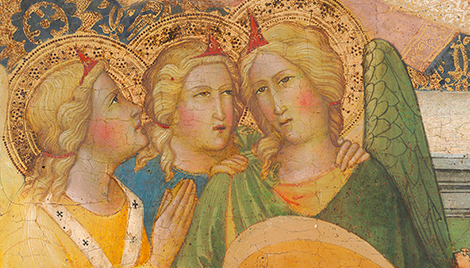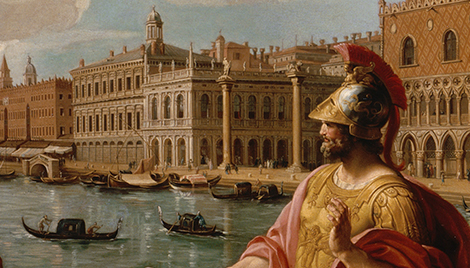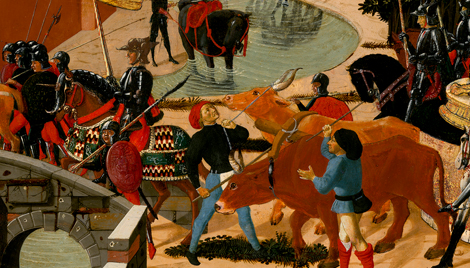Kress Travels: The Museum of Fine Arts, Houston
In February, the Kress Foundation Board of Trustees and staff travelled to Houston, Texas to visit our colleagues at the Museum of Fine Arts, Houston, a repository of the Kress Collection. Read on to learn more about the Kress Collection at MFAH, both past and present.
A Brief History of the Kress Collection at MFAH
In December 1929, Samuel H. Kress first wrote to his friend, Jesse Jones, a prominent Houston businessman, politician, and philanthropist, regarding his intention to make a gift to the Museum of Fine Arts, Houston, driven “to do something that will be of benefit and enjoyment to the people of Houston.” Kress selected a Venetian painting of the Holy Family, then-attributed to Lorenzo Lotto, as his first gift to the young museum. Still in the early stages of building its collection, the Lotto painting also marked the first gift to the institution by a non-Houstonian. Kress gave a subsequent gift to the museum in 1934 of two panels by the Lombard School. These early gifts by Kress were the first major examples of Old Master paintings to enter the museum’s collection and were instrumental in encouraging further contributions to the museum by other donors.
Left: 1930s view of Lombard school paintings on view at Museum of Fine Arts, Houston; Right: Exterior of Museum of Fine Arts, Houston, 1939 (Image source: Kress Foundation Archive)
After Lorenzo Lotto (Italian, c. 1480-1556/1557), The Holy Family with a Donatrix as Saint Catherine of Alexandria, c. 1540-45, oil on canvas, Samuel H. Kress Collection, Museum of Fine Arts, Houston
Of these early gifts, Kress wrote in a 1934 letter to James Chillman, then-director of the MFAH, “The thought might arise in the minds of certain people why I am expressing my interest in Houston in this manner and I wish to say that it is apparent that opportunities to obtain genuinely old paintings of quality within the range of being acquired by museums throughout the United States are continually getting fewer for naturally the number of genuinely old paintings is limited… I hope the paintings will give as much pleasure and satisfaction to the people of Houston and vicinity as it gives me pleasure to present them and that they will grow in favor as time goes on.”
In October 1953, a permanent loan of 30 objects from the Kress Collection was installed at the museum in the newly renovated Sterling Wing, coinciding with the opening of the Robert Lee Blaffer Memorial Wing. Portions of the Kress Collection, beyond the initial gifts of the 1930s, were exhibited at the MFAH in 1933 as part of the national tour of the Kress Collection to cities including Atlanta, Memphis, Birmingham, New Orleans, Houston, and Dallas. The loaned Kress works were offered as a gift to the MFAH in 1961.
Kress Collection on View at MFAH
Today, a selection of works from the Kress Collection gift are on view at the MFAH, primarily in the Audrey Jones Beck Building which holds the museum’s collections of European art, ancient art, photography, prints & drawings, and American art.
Audrey Jones Beck Building, Museum of Fine Arts, Houston
The European art galleries at the Museum of Fine Arts, Houston were reimagined and reinstalled in 2022. The new installation spans the Middle Ages through the eighteenth century and presents works from Europe, Central America, and South America. MFAH director Gary Tinterow commented, “This new, interdisciplinary presentation furthers a new approach to our collections. Following on the reinstallation of our American galleries, in 2020, we have similarly rethought the display of our European collections to more fully express the history, culture, and faith in which these works were originally created and experienced.”
Kress Collection paintings may be found throughout the European galleries, illustrating key moments in European art history. Below are a few highlights.
Lombard Master (Italian, 15th century), Saints Anthony Abbot and John the Baptist with a Donor (left) and Saints Margaret and Catherine of Alexandria with Donatrix (right), c. 1485, tempera and gold leaf on panel, Samuel H. Kress Collection, Museum of Fine Arts, Houston
Botton Right: Michele Tosini (Italian, 1507–1577), Saint Mary Magdalene, 1560s, oil on panel, Samuel H. Kress Collection, Museum of Fine Arts, Houston
Top Left: Domenico Tintoretto (Italian 1560–1635), Tancred Baptizing Clorinda, c. 1586-1630, oil on canvas, Samuel H. Kress Collection, Museum of Fine Arts, Houston
“The subject of Tancred baptizing Clorinda is taken from an episode in Italian poet Torquato Tasso's romantic epic Jerusalem Delivered (1575–76), an idealized account of the first crusade against the Saracens. The crusade ended with the capture of Jerusalem in 1099 and the establishment of a Christian kingdom. In the poem, Christian knight Tancred has dueled with and mortally wounded his Saracen love, Clorinda, whom he failed to recognize in battle dress. Domenico Tintoretto depicts the moment in which Tancred brings water for the baptism from a nearby brook, recognizing Clorinda's identity only as he unlaces her helmet. As Tancred kneels in full armor, pouring water from his helmet, Clorinda appeals to him with her dying breath to baptize her in the Christian faith.” (MFAH Collection Online)
Orazio Gentileschi (Italian, 1563–1639), Portrait of a Young Woman as a Sibyl, c. 1620, oil on canvas, Samuel H. Kress Collection, Museum of Fine Arts, Houston
“The young woman in this painting by Orazio Gentileschi has been identified by scholars as the artist's daughter, Artemisia Gentileschi. A renowned painter herself, she trained in her father's workshop and established a European reputation that allowed her a life of independence rare for a woman of her day.
One of the most important followers of Michelangelo Merisi da Caravaggio (1571/72–1610), Orazio Gentileschi combined a refined and elegant personal manner with Caravaggio's powerful sense of realism. In this painting, the identification of Artemisia as a Sibyl—defined in ancient Greek literature and legend as a woman with the gift of prophecy—may be based on what happened during the trial of Roman artist Agostino Tassi, whom she accused of rape. She voluntarily submitted to a torture called the sibyls, which involved a device consisting of metal rings that were tightened about the fingers by a set of cords to determine the truth.
The view of the sibyl and her upturned head are typical features of Orazio Gentileschi's heroines, and the rendering of her sumptuous orange brocade drapery anticipates the increased elegance of his later painting. His precociously gifted daughter possessed a formidable personality, and she became not only one of the greatest of Caravaggesque painters but also a heroine to feminist art historians.” (MFAH Collection Online)
Right: Bartolomé Esteban Murillo (Spanish, 1617–1982), The Virgin of the Annunciation, 1670-80, oil on canvas, Samuel H. Kress Collection, Museum of Fine Arts, Houston
Left: Juan van der Hamen y León (Spanish, 1596–1631), Still Life with Fruit and Glassware, 1626, oil on canvas, Samuel H. Kress Collection, Museum of Fine Arts, Houston
“Reminiscences of abundant Flemish still lifes, such as those painted by Frans Snyders, occasionally may be found in Van der Hamen’s works, but more fundamentally influential were the starkly lit, abstract arrangements of ordinary fruits and vegetables by his Spanish predecessor Juan Sánchez Cotán. Van der Hamen transformed this model by infusing his own still lifes with monumental grandeur and a courtly elegance.
Brilliantly lit and warmly colored, these heavy fruits dominate the cool hues and delicate forms of purple plums, white grapes, and three glass vessels that emerge from the deep shadows on the middle ledge. The amplitude of space that comes from the greater distance between the viewer and the majestic, dignified display is unique to Van der Hamen’s work to this time.” (A Gift to America: Masterpieces of European Painting from the Samuel H. Kress Collection, p. 143)



